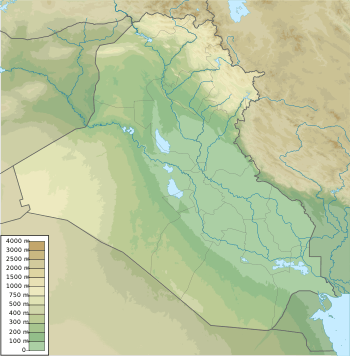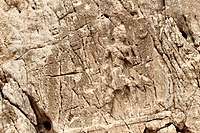Iddin-Sin
Iddin-Sin (Akkadian: 𒀭𒄿𒋾𒀭𒂗𒍪: DI-ti-n Sîn) was a King (𒈗 Šàr, pronounced Shar)[1] of the Kingdom of Simurrum circa 2000-1900 BCE. Simurrum was an important city state of the Mesopotamian area, during the period of the Akkadian Empire down to Ur III. The Simurrum Kingdom disappears from records after the Old Babylonian period.[2] According to an inscription (the stela now located in the Sulaymaniyah Museum), Iddin-Sin seems to have been contemporary with Lullubi king Annubanini.[3][4]
| Iddin-Sin 𒀭𒄿𒋾𒀭𒂗𒍪 | |
|---|---|
| King of Simurrum | |
.jpg) Iddin-Sin, King of Simurrum, armed with a bow and an axe, trampling a foe. Circa 2000 BCE (extracted detail) | |
| Reign | c. 2000-1900 BCE |

Several rulers of the Simurrum Kingdom are known, such as Iddin-Sin and his son Zabazuna.[2] Various inscriptions suggest that they were contemporary with king Ishbi-Erra (1953—c.1920 BCE).[5] In inscriptions, the name of Iddin-Sin is written 𒀭𒄿𒋾𒀭𒂗𒍪, with one silent honorific (𒀭, "Divine") before the phonological part of the name, 𒄿𒋾𒀭𒂗𒍪, where the second 𒀭 (An) has the value of "n". The last part 𒂗𒍪 was initially En-Zu but is pronounced Sîn, name of the Moon God.[1]
Four inscription and a relief of the Simurrum have been identified at Bitwata near Ranya in Iraqi Kurdistan, near the border with Iran, including the large relief now in the Israel Museum, and one from Sarpol-e Zahab.[6][5] It is thought that the design of the relief is derived from the Victory Stele of Naram-Sin, King of the Akkadian Empire (2254-2218 BCE), in which the king is also seen trampling enemies.[7] It is also similar to other reliefs in the area, such as the Anubanini rock relief. The Sarpol-e Zahab relief, representing a beardless warrior with axe, trampling a foe, and inscribed with the name "Zaba(zuna), son of ...", may be the son of Iddin-Sin.[5]
Iddi-Sin is also known from a stele, which he inscribed in the Akkadian language, now in the Sulaymaniyah Museum, Iraq.
A seal showing Iddin-Sin and his son Zabazuna (Akkadian: 𒍝𒁀𒍪𒈾: Za-ba-zu-na), is also known from the Rosen collection.[1]
.jpg) King Iddin-Sin of the Kingdom of Simurrum, holding an axe and a bow, trampling a foe, facing Ishtar. Circa 2000 BCE. Israel Museum
King Iddin-Sin of the Kingdom of Simurrum, holding an axe and a bow, trampling a foe, facing Ishtar. Circa 2000 BCE. Israel Museum Stela of Iddi-Sin, King of Simurrum. It dates back to the Old-Babylonian Period. From Qarachatan Village, Sulaymaniyah Governorate, Iraqi Kurdistan. The Sulaymaniyah Museum, Iraq
Stela of Iddi-Sin, King of Simurrum. It dates back to the Old-Babylonian Period. From Qarachatan Village, Sulaymaniyah Governorate, Iraqi Kurdistan. The Sulaymaniyah Museum, Iraq Sarpol-e Zahab, relief I. Beardless warrior with axe, trampling a foe. Sundisk above. A name "Zaba(zuna), son of ..." can be read. He is usually considered as a ruler of the Lullubi,[8][9] but he could be a ruler of the Kingdom of Simurrum, son of Iddin-Sin.[5]
Sarpol-e Zahab, relief I. Beardless warrior with axe, trampling a foe. Sundisk above. A name "Zaba(zuna), son of ..." can be read. He is usually considered as a ruler of the Lullubi,[8][9] but he could be a ruler of the Kingdom of Simurrum, son of Iddin-Sin.[5].jpg) Portrait of Iddin-Sin, King of Simurrum, c. 2000 BC (detail)
Portrait of Iddin-Sin, King of Simurrum, c. 2000 BC (detail).jpg) Enemy being trampled by Iddin-Sin, probably a vanquished rebel called Aurnahuš in the accompanying inscription.[10] (detail)
Enemy being trampled by Iddin-Sin, probably a vanquished rebel called Aurnahuš in the accompanying inscription.[10] (detail) The name "Iddin-Sin" (𒀭𒄿𒋾𒀭𒂗𒍪, I-ti-n Sîn) with the initial silent honorofic 𒀭 for "Divine", on the stele in the Sulaymaniyah Museum, Iraq.
The name "Iddin-Sin" (𒀭𒄿𒋾𒀭𒂗𒍪, I-ti-n Sîn) with the initial silent honorofic 𒀭 for "Divine", on the stele in the Sulaymaniyah Museum, Iraq.
References
- Shaffer, Aaron (2003). Iddi(n)-Sîn, King of Simurrum: A New Rock-Relief Inscription and a Reverential Seal. Zeitschrift für Assyoriologie. pp. 32–35.
- Eidem, Jesper (2001). The Shemshāra Archives 1: The Letters. Kgl. Danske Videnskabernes Selskab. p. 24. ISBN 9788778762450.
- Osborne, James F. (2014). Approaching Monumentality in Archaeology. SUNY Press. p. 123. ISBN 9781438453255.
- History of Iddin-Sin's stela
- Frayne, Douglas (1990). Old Babylonian Period (2003-1595 BCE). University of Toronto Press. pp. 707 ff. ISBN 9780802058737.
- Osborne, James F. (2014). Approaching Monumentality in Archaeology. SUNY Press. p. 120. ISBN 9781438453255.
- "Rock relief of Iddin-Sin, King of Simurrum". Europeana.
- Osborne, James F. (2014). Approaching Monumentality in Archaeology. SUNY Press. pp. 123–124. ISBN 9781438453255.
- Osborne, James F. (2014). Approaching Monumentality in Archaeology. SUNY Press. pp. 123–124. ISBN 9781438453255.
- Shaffer, Aaron (2003). Iddi(n)-Sîn, King of Simurrum: A New Rock-Relief Inscription and a Reverential Seal. Zeitschrift für Assyoriologie. p. 3.